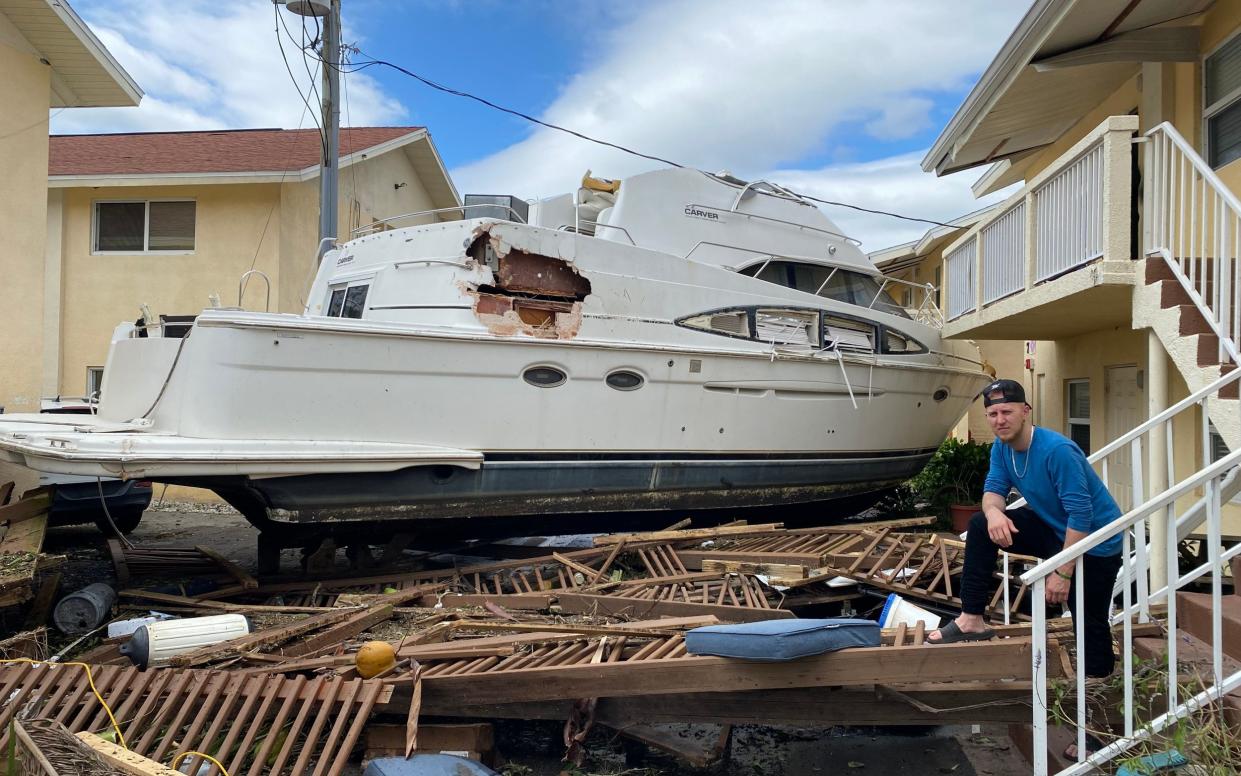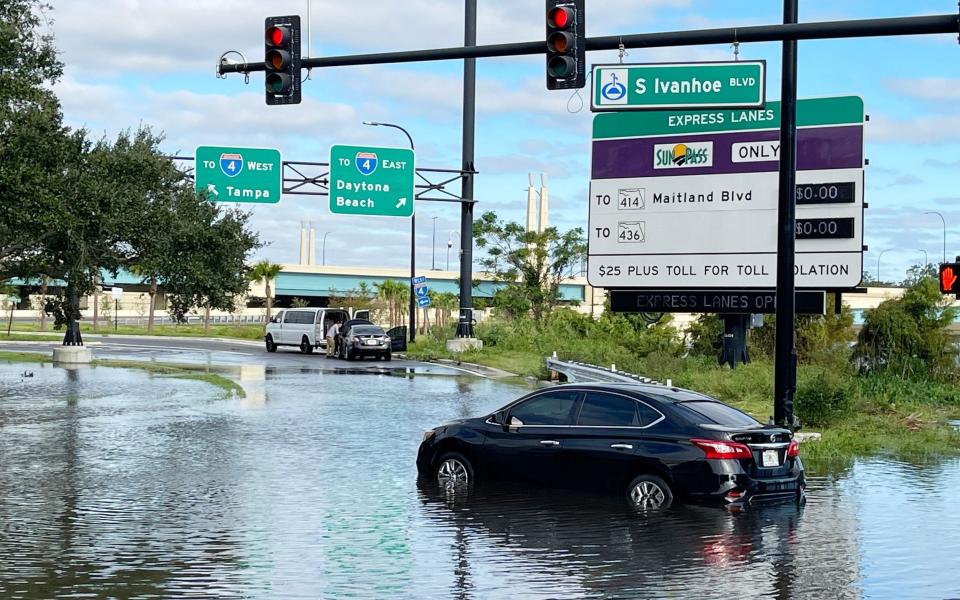Hurricane Ian: ‘911 couldn’t come out. I had to get down and help her’

It was the sight of a grey Ford Mustang floating past Gage Long’s second floor window which made him step out on to the balcony for a better look at the damage Hurricane Ian was inflicting.
The 29-year-old barman couldn’t believe what was coming next.
Riding a storm surge of more than eight feet, a 47ft motor yacht came crashing through the narrow road at his apartment complex in Fort Myers and slammed into his concrete building, its bow grinding against the very balcony on which he was standing.
Below him, on the ground floor, his elderly neighbour Brenda Brennan was trapped.
“911 couldn’t come out. I had to get down and help her,” Mr Long told The Telegraph.
It was not a straightforward operation.
“The water was murky, you couldn’t see what was in it,” he said, pointing down to the snapped wood and twisted metal on the ground – visible now the water had receded.
“We have bull sharks in the bay. There are gators all over this area. Then you’ve got live wires, gas leaks, sharp objects, floating vehicles and a huge boat right over you. The water is not where you want to be. But we had to get her out.”
As the sun began to set, and with the air thick with the smell of diesel, Mr Long waded through the chest-high water to a ground-floor window, where he pulled his neighbour out and carried her up the external stairs to his apartment.
“She was pretty fragile but we gave her clean clothes and a place to sleep. She kept her phone dry so we charged that and when service came back, called her family to let them know she was safe. It was a pretty wild night.”
Ms Brennan, who has now left the area, was one of the luckier ones. At least a dozen people are confirmed to have died during the storm.
Joe Biden, the US president, has warned that it “could be the deadliest hurricane in Florida’s history”, adding: “The numbers are still unclear but we are hearing early reports of what may be a substantial loss of life.”
On Friday Ron DeSantis, the Florida governor, still did not give a formal death toll but said that rescuers had visited more than 3,000 homes looking for people who may be trapped.
By Friday morning the coast guard had rescued 95 people, 10 dogs, eight cats and one bird, swooping low over the barrier islands in their Chinooks and Blackhawk helicopters.
More than 600 others were taken to safety by boat or another emergency vehicle.
Some 20,000 Floridians have been displaced and are staying in shelters. Many more are in hotels, with friends and family or left the state completely ahead of the incoming storm.
Kevin Anderson, the mayor of Fort Myers, which was the first place on the mainland to be hit by the 150mph winds, said: "It looks like a war zone."
Even getting to the town of 83,000 people is difficult. Palm trees have collapsed on to main roads, power lines are down, sewers are flooding and the traffic lights are not working, leaving cars crawling across junctions.
Then there is the detritus. Traffic slowed to drive around a small motorboat which was blocking the road right beside the sign that said “Welcome to Fort Myers”. In the left-hand lane just a few yards ahead was a jetski.
On nearby San Carlos Island it was perhaps little surprise that the first two words uttered by Tracy Rudge, 34, as she entered her home for the first time since the hurricane hit were “holy” and “f---.”
The high watermark was above the side of her house. The single-storey structure had, at one point over the past 24 hours, been completely submerged.
Sloshing through in thick, clumpy grey sludge, the pub worker originally from Maine let out various cries of joy and despair. Her enormous fridge freezer had been thrown across the kitchen and was now face down on the floor. A pair of leopard print Converse shoes were practically untouched.

“Possessions are replaceable but lives are not,” she said, philosophically. “But those Converse are limited edition, so I’m so happy they made it.”
The random destruction of the category four hurricane is best viewed from the sky and best illustrated by the incredible spread of boats, some more than a mile inland. One was wedged against a petrol pump, many were lying in the middle of the road, some were lodged in houses and others had been flipped over garden walls. Here, too, the smell of diesel filled the air.
Just across the water, at Fort Myers Beach, on Estero Island, the scene is even more devastating.


“Ninety per cent of the island is gone,” said Dan Allers, a city councillor.
“I walked three or four miles down the island and every home on the beach is gone. Some of the homes on the side streets have completely gone and only a hole in the ground filled with water remains. Some structures just have concrete pillars remaining.
“Some of the buildings in the entertainment district have been there for decades. Now it’s as if they were never there.
“We have had some confirmed deaths. I don’t know how many. I fear there are many, many more who are not going to be so lucky.”
People who decided to stay put because the hurricane was due to hit 100 miles north, but then took a sharp right, were desperate to escape.

“One man tried to float away on his mattress. Others tried to ride on refrigerators to higher ground,” he added.
The hurricane has now barrelled through Florida, gained strength in the Atlantic and was expected to hit Charleston, South Carolina, on Friday night.
Federal assistance is pouring in. Food and drink is being distributed, generators are arriving, convoys of ambulances and other emergency vehicles have headed to the worst-affected areas. There is a long road ahead.
“I just received another message this morning from another resident that there’s a body hanging out of a window in one of the buildings towards the south bend,” said Mr Allers.
“So as soon as we get off the phone, I’ll be reaching out to the sheriff’s department to relay that information and we’ll be back out on the streets as soon as we can.”

 Yahoo Movies
Yahoo Movies 
